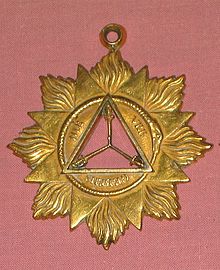To the three swords
" To the three swords " refers to a Masonic lodge in Halle (Saale) , which existed from 1765 to 1934 .
prehistory
In 1743 five law students met in Halle to found a lodge. The installation of the lodge, which was called "To the three golden keys", took place on December 14, 1743. The patent required for this was issued to the founders in Berlin on December 6th by the later Grand National Mother Lodge “To the Three Worlds” (aux trois globes). The lodge dissolved again in 1749 or 1750. The exact time and the reasons for the dissolution could not be clarified to this day due to the torn out protocol pages. Hammer leading masters were Carl Samuel von Brukenthal (1743–1744), Balthasar Friedrich von Mitthoff (1744–1746) and David Samuel v. Madai (1746-1750?).
On December 11, 1756, eight Freemason brothers founded a new lodge in the "Glückschen Haus" at 1009 Kleine Ulrichstrasse, which was called "Philadelphia for the three golden arms". Co-founder and first secretary was Johann Christoph Adelung . This lodge, as has long been claimed, is not a successor lodge, since no previous members joined it. The lodge “To the three golden keys” was also re-established in Berlin in 1769 on the basis of the earlier patent. In 1758, first lieutenant August Wilhelm von Vietinghoff was accepted into the lodge and in 1763 elected as the last master from the chair. Because by order of the highest order, the lodge had to disband on November 10, 1764.
The box "To the three swords"

In 1764 von Vietinghoff and the military doctor Johann Wilhelm Kellner von Zinnendorf founded the third Halle Masonic lodge "To the three swords" and from 1765 held the office of chair master, who was called "Hauskomtur" within the strict obeservance. Due to his relationships with the Prussian royal family and the resulting reputation, he often acted as a mediator in disputes within the various Masonic schools of his time. The lodge also belonged to the Great National Mother Lodge “To the Three Worlds” in Berlin. At times it had over 500 members at the same time. Her jewel contained three inwardly directed swords arranged in a star shape in a triangle, which was surrounded by an ouroboros , in which the motto of the lodge was "never in vain". Outside was an eight-pointed flamed star. At the suggestion of the lodge member Johann Christian Reil , the lodge acquired land on March 3, 1792 at Moritzburgring 10 in Halle for 4,300 thalers. First of all, the three buildings on the property were converted for their purposes. The inauguration of the Logenhaus Halle took place on December 7, 1792. An increase in the number of members made a new building necessary, which was built from 1821 to 1824 on parts of the previous development according to plans by the city architect Johann Justus Peter Schulze . Further modifications were made in 1868 and 1888.
At the time of its existence, the lodge had a total of 2275 full members.
Well-known lodge members
- Daniel Nettelbladt (1719–1791)
- August Wilhelm von Vietinghoff (1728–1799)
- Johann Reinhold Forster (1729–1798)
- Johann Christoph von Wöllner (1732–1800)
- Hans Rudolf von Bischoffwerder (1741–1803)
- Johann Friedrich Gottlieb Goldhagen (1742–1788)
- Heinrich Philipp Goldhagen (1746–1826)
- Christian Friedrich zu Stolberg-Wernigerode (1746–1824)
- Justus Christian Loder (1753-1832)
- Gabriel Wilhelm Keferstein (1755-1816)
- Friedrich August Wolf (1759-1824)
- Johann Christian Reil (1759-1813)
- Friedrich Albrecht Carl Gren (1760–1798)
- Johann Gebhard Maaß (1766–1823)
- Ferdinand Beneke (1774–1848)
- Johann Friedrich Christian Düffer (1775–1831)
- Karl Christoph Schmieder (1778–1850)
- Ludwig Gottfried Blanc (1781–1866)
- Friedrich Wilhelm Malotki von Trzebiatowski (1790–1867)
- Karl August Wilhelm Bertram (1788–1868)
- Friedrich August Eckstein (1810–1885)
- Friedrich August Arnold (1812–1869)
- Wilhelm Gottlieb Hankel (1814–1899)
- Gustav Friedrich Hertzberg (1826–1907)
- Albert Dehne (1832–1906)
literature
- Friedrich August Eckstein: History of the Freemason Lodge in the Orient of Halle, a festive gift for the secular celebration of the Lodge on the three swords. Hall a. P. 1844.
- Carl Hugo Freiherr vom Hagen: The city of Halle, according to official sources historically-topographically-statistically represented. At the same time supplement and continuation of Dreyhaupt's Chronicle. Hall 1844/1867.
- Gustav Friedrich Hertzberg: History of the Masonic Lodge "To the three swords" in the Orient of Halle, commemorative publication for the 150th anniversary of the Lodge. Hall a. P. 1893
- Gustav Friedrich Hertzberg: History of the Masonic Lodge to the three swords in the Orient from Halle 1843-1893 , Halle a. P. 1893
- Guntram Seidler: The history of Halle's Johannisloge zu den Drei Degen , Halle (S.) 2009 self-published
- Renko Geffarth: Brother Studiosus, Brother Professor, Freemason at the University of Halle in the 18th century , in: scientia halensis - University magazine of the Martin Luther University Halle-Wittenberg, issue 2/2007, p. 12
- Werner Piechocki: The beginnings of Freemasonry in Halle, student and professor lodges , in: Erich Donnert (ed.), Europe in the early modern times, Weimar / Cologne / Vienna 1997-2007, Vol. 4: German Enlightenment (1997), p 479-486
- Holger Zaunstöck: The Halle enlightenment societies in the 18th century. A structural analysis, in: Erich Donnert (ed.), Europe in the early modern times, Weimar / Cologne / Vienna 1997–2007, Volume 5: Enlightenment in Europe (1999), pp. 43–63
Web links
Individual evidence
- ↑ Guntram Seidler: The history of Halle's Johannisloge “To the three golden keys” 1743–1934 (1937), self-published, Halle 2012, pp. 6–18
- ↑ Guntram Seidler: The history of Halle's Johannisloge “To the three golden keys” 1743–1934 (1937), self-published, Halle 2012, pp. 18–25
- ↑ Hanns-Peter Neumann: Journey into the realm of unreason: Enlightened amusement with Johann Christoph Adelung . In: Günter Frank, Anja Hallacker, Sebastian Lalla (eds.): Narrative reason. Akademie Verlag, Berlin 2006, p. 63. ( PDF ( Memento from December 20, 2015 in the Internet Archive ))


